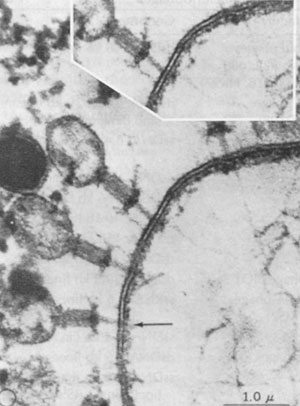
This Article From Issue
July-August 2002
Volume 90, Number 4
DOI: 10.1511/2002.27.0
Lateral DNA Transfer: Mechanisms and Consequences. Frederic Bushman. xvi + 448 pp. Cold Spring Harbor Laboratory Press, 2002. Cloth, $59; paper, $39.
When we think of genetic transfer, we think of the transfer of genes from parent to offspring. The phenomenon of lateral (or horizontal) gene transfer represents a departure from this standard paradigm: The organisms involved can belong to different species, or even different kingdoms. In a typical example, a genetic sequence can be virtually lifted out of a chromosome of one organism and deposited directly into the chromosome of an unrelated organism by way of a vector such as a virus or plasmid. Although lateral transfer has been observed and studied in bacteria in the laboratory for almost 50 years, its extent in nature and potential significance have only recently been appreciated. Lateral DNA Transfer is therefore a timely book.

From Lateral DNA Transfer.
In it Frederic Bushman explains the mechanisms responsible for horizontal transfer as well as the recent evidence from the genome projects indicating that horizontal transfer has in fact taken place. Educated laypeople and scientists whose expertise lies in areas other than genomics will profit from reading this book. This is appropriate, because gene transfer affects so many different fields—from academic taxonomy and paleontology, to ecology and environmental sciences, to agriculture and biotechnology. Although Bushman provides all of the background needed for understanding this vast topic, the book will be easier to read for those who have at least an undergraduate course in genetics or molecular biology under their belt.
The first half of the book summarizes the mechanisms of gene transfer between different species in the bacterial and archaeal worlds. Bushman describes thoroughly the relevant molecular mechanisms involved in DNA transfer from one cell to another and the processes for incorporating foreign DNA in the new cell. There is evidence that horizontal gene transfer played an important role in the emergence of the earliest kingdoms of life a few billion years ago and has continued to shape the architecture of bacterial genomes over the past 100 million years. Over the past several thousand years, horizontal transfer has been an important factor that has contributed to the molding of new bacterial communities as they adapt to humanity. Horizontal transfer has played a role in the adaptation of bacteria to live in polluted soils and rivers and to resist antibiotic use by mankind. It has perhaps even played a role in the creation of new disease-causing pathogens. Bushman's descriptions of all this are comprehensive, and his presentation is engaging.
The latter half of the book describes the eukaryotic world. Each of these chapters is an interesting, well-written essay on the subject at hand. However, some chapters tend to diverge from the main topic. A complete chapter on the AIDS virus and another on the recombination pathways that generate somatic cell diversity in the immune system have very little to do with horizontal transfer other than sharing certain mechanisms with some mobile genetic elements (which in themselves are not necessarily involved in transfer). Perhaps Bushman believed that there was so little material concerning eukaryotes that he needed to use tangentially related material. That is unfortunate, because he missed some opportunities here, particularly in devoting only two pages to the endosymbiotic origins of the modern eukaryotic cell. One of the more spectacular examples of horizontal gene transfer, it involves probable fusions between bacteria (and possibly archaea) and a more primitive cell type that occurred about 2 billion years ago, giving rise to the mitochondria, chloroplasts and perhaps other subcellular organelles.
I would also have liked to see a more thorough discussion of some of the possible evolutionary implications of lateral transfer, such as a discussion of the literature on the implications of lateral transfer with respect to our understanding of macroevolutionary trends of metazoa and flowering plants. There are, for example, outstanding questions in biology concerning convergent evolution and group selection above the species level. A number of authors have suggested that lateral gene transfer offers a mechanism that can help explain these phenomena. Bushman briefly references these arguments—and summarily dismisses them.
What would be lost by being more intellectually adventuresome and discussing these more speculative and far-reaching ideas? Lateral gene transfer is, after all, one of the more surprising biological discoveries of the past few decades. Although the ability to transfer genes laterally in a laboratory setting has already revolutionized our approach to applied biology, we have been relatively slow in exploring the potential theoretical implications of lateral gene transfer in nature. I am optimistic that this excellent book, despite its somewhat conservative approach, will stimulate future investigators to delve into the exciting possibilities.—Michael Syvanen, Microbiology, School of Medicine, University of California, Davis
American Scientist Comments and Discussion
To discuss our articles or comment on them, please share them and tag American Scientist on social media platforms. Here are links to our profiles on Twitter, Facebook, and LinkedIn.
If we re-share your post, we will moderate comments/discussion following our comments policy.